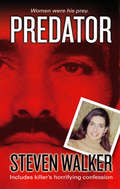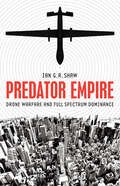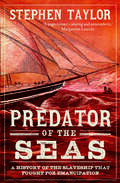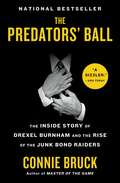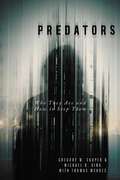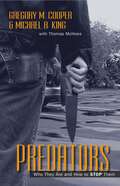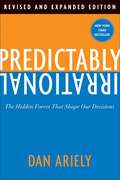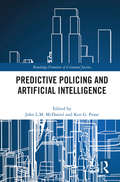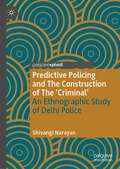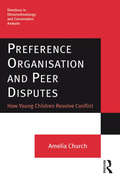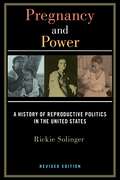- Table View
- List View
Predator
by Steven WalkerHe Stalked His Victims. . .A mother and daughter--brutalized, murdered, and left to rot in the summer heat. A young college student--killed with a .38 handgun at a remote highway rest stop. These were just a few of the victims of Timothy Krajcir, a sexual predator with an unquenchable appetite for violence. . . From State To State. . .He would travel to towns where nobody knew him, break into a woman's home, and wait for her. It started when he was still in his teens, when a rape conviction landed Krajcir in jail. After that, he spent much of his adult life behind bars for various sex crimes. By the time he was in his early 30s, he was a free man. Free to stalk, rape, and kill.Three Decades Of Murder And Blood. . .But in 2007, new DNA testing finally linked Krajcir to another college girl's murder. Ultimately, Krajcir confessed to killing nine women--five in Missouri and four in Illinois and Pennsylvania. But his three-decade reign of terror has never been forgotten--and the full range of his predatory crimes never revealed--until now.With 16 Pages Of Shocking Photos
Predator Empire: Drone Warfare and Full Spectrum Dominance
by Ian G. ShawWhat does it mean for human beings to exist in an era of dronified state violence? How can we understand the rise of robotic systems of power and domination? Focusing on U.S. drone warfare and its broader implications as no other book has to date, Predator Empire argues that we are witnessing a transition from a labor-intensive &“American empire&” to a machine-intensive &“Predator Empire.&” Moving from the Vietnam War to the War on Terror and beyond, Ian G. R. Shaw reveals how changes in military strategy, domestic policing, and state surveillance have come together to enclose our planet in a robotic system of control. The rise of drones presents a series of &“existential crises,&” he suggests, that are reengineering not only spaces of violence but also the character of the modern state. Positioning drone warfare as part of a much longer project to watch and enclose the human species, he shows that for decades—centuries even—human existence has slowly but surely been brought within the artificial worlds of &“technological civilization.&” Instead of incarcerating us in prisons or colonizing territory directly, the Predator Empire locks us inside a worldwide system of electromagnetic enclosure—in which democratic ideals give way to a system of totalitarian control, a machinic &“rule by Nobody.&” As accessibly written as it is theoretically ambitious, Predator Empire provides up-to-date information about U.S. drone warfare, as well as an in-depth history of the rise of drones.
Predator of the Seas: A History of the Slaveship that Fought for Emancipation
by Stephen TaylorThe dramatic biography of a slaveship turned freedom-fighter—which brings new insights into Britain’s involvement in the end of the trade in enslaved people In 1827 the Royal Navy purchased a Baltimore clipper and renamed her the Black Joke. Assigned to the Preventative Squadron, she patrolled the west coast of Africa and freed 3,692 captives from enslavement. Beloved by seafarers and celebrated by the public, the Black Joke would become the most famous weapon in the campaign for abolition. But in her previous life as the Henriqueta, the Black Joke had been a slave ship. Through the experiences of slavers and abolitionists, captives and crew, Stephen Taylor charts the vessel’s extraordinary double life. As the Henriqueta she operated as an engine of atrocity, trafficking over 3,000 captives to plantations in Brazil. But subsequently manned by British seamen and Liberian Kru, the Black Joke became the scourge of Spanish and Brazilian slavers. She did so despite limited resources, neglect, and even obstruction by the authorities at home. Taylor offers a gripping account of the world of the transatlantic trade, through the eyes of its perpetrators—and those who sought its end.
Predator's Ball: The Inside Story of Drexel Burnham and the Rise of the Junk Bond Raiders
by Connie BruckDuring the '80s, Michael Milken at Drexel Burnham created the corporate raiders. He was the billionaire Junk Bond King. But, in the corner stood the U.S. District Attorney waiting to file criminal and racketeering charges.
Predator: A Memoir, a Movie, an Obsession
by Ander MonsonA searching memoir of a life lived in the flicker of an action film, by the author of I Will Take the Answer In his first memoir, Ander Monson guides readers through a scene-by-scene exploration of the 1987 film Predator, which he has watched 146 times. Some fighters might not have time to bleed, but Monson has the patience to consider their adventure, one frame at a time. He turns his obsession into a lens through which he poignantly examines his own life, formed by mainstream, white, male American culture. Between scenes, Monson delves deeply into his adolescence in Michigan’s Upper Peninsula and Riyadh, his role as a father and the loss of his own mother, and his friendships with men bound by the troubled camaraderie depicted in action and sci-fi blockbusters. Along with excursions into the conflicted pleasures of cosplay and first-person shooters, he imagines himself beside the poet and memoirist Paul Monette, who wrote the novelization of the movie while his partner was dying of AIDS.A sincere and playful book that lovingly dissects the film, Predator also offers questions and critiques of masculinity, fandom, and their interrelation with acts of mass violence. In a stirring reversal, one chapter exposes Monson through the Predator’s heat-seeking vision, asking him, “What do you know about the workings of the hidden world?” As Monson brings us into the brilliant depths of the film and its universe, the hunt begins.
Predator: Rape, Madness and Injustice in Seattle
by Jack OlsenJack Olsen, "the master of the true crime book," now gives us an incisive, probing look into the creation and development of the criminal mind, as well as a shocking case of justice gone awry. From childhood, McDonald Smith took to heart the lessons drummed into him by antisocial relatives and peers. As a teenager, unburdened by conscience or pity, he experimented with child abuse and bestiality, then moved on to larceny, stickups, incest, and, finally, rape. Warned by a "witch" that he was about to be arrested, he fled Los Angeles for Seattle and the Northwest--already the breeding ground of predatory monsters like Ted Bundy, Kenneth Bianchi, and the Green River Killer. There, for years, he stalked the women of Seattle, seeking his prey on the dark streets and in the quiet homes, then returning to his wife and family: too careful--and too clever--to be caught. By fall 1980, Mac Smith's luck still held. A respectable young businessman named Steve Titus found himself charged with one of Smith's most sadistic rapes in a nightmarish case of mistaken identity and injustice. The idealistic Titus was certain that the American system of justice would clear him--right up to the day that a jury of his peers returned a verdict of guilty as charged. While Mac Smith continued to terrorize the women of Seattle, Titus lost everything: his reputation, his job, his loved ones, his freedom. It was only when a Pulitzer prizewinning reporter answered Titus's pleas for justice that the terrible truth emerged: a truth that was darker than anyone imagined. Predator is a gripping work of true crime reporting: Jack Olsen doing what he does best. It is a searing study of violations: of women, of justice, of power, and of the human spirit.
Predators: Who They Are and How to Stop Them
by Gregory M. Cooper Michael R KingMost of us only half-listen to the public service announcements about safety in the home. We lock our doors at night, but do little else to change habits that may make us the next victims of the dangerous individuals who are always on the watch for their next opportunity. This updated paperback edition takes readers through the mindset of predatory criminals - their motives, various plans of attack, and way of thinking - and then teaches simple lifestyle techniques that will help reduce the risk of becoming victimized. Featuring a new chapter on how the Internet and social media has radically changed how some predators operate, criminal behavior specialists Greg Cooper and Mike King provide expert analysis based on real-life cases, in addition to moving insights from victims and criminals themselves. The authors make the point that the people who commit these crimes aren't much different from the predators of the wild, preying on the weak and unsuspecting. What makes these individuals more dangerous than their instinctive wildlife counterparts, however, is that they consciously choose to inflict their will on the more vulnerable members of their own species. To protect our loved ones and ourselves requires that we truly educate ourselves about the predators who live in our society and then take appropriate action. This excellent, in-depth study will help readers lead safer lives.
Predators: Who They Are and How to Stop Them
by Gregory M. CooperMost of us only half-listen to the public service announcements about safety in the home. We lock our doors at night, but do little else to change habits that may make us the next victims of the dangerous individuals who are always on the watch for their next opportunity. This updated paperback edition takes readers through the mindset of predatory criminals - their motives, various plans of attack, and way of thinking - and then teaches simple lifestyle techniques that will help reduce the risk of becoming victimized. Featuring a new chapter on how the Internet and social media has radically changed how some predators operate, criminal behavior specialists Greg Cooper and Mike King provide expert analysis based on real-life cases, in addition to moving insights from victims and criminals themselves. The authors make the point that the people who commit these crimes aren't much different from the predators of the wild, preying on the weak and unsuspecting. What makes these individuals more dangerous than their instinctive wildlife counterparts, however, is that they consciously choose to inflict their will on the more vulnerable members of their own species. To protect our loved ones and ourselves requires that we truly educate ourselves about the predators who live in our society and then take appropriate action. This excellent, in-depth study will help readers lead safer lives.
Predatory Data: Eugenics in Big Tech and Our Fight for an Independent Future
by Anita Say ChanThe first book to draw a direct line between the datafication and prediction techniques of past eugenicists and today's often violent and extractive "big data" regimes. Predatory Data illuminates the throughline between the nineteenth century's anti-immigration and eugenics movements and our sprawling systems of techno-surveillance and algorithmic discrimination. With this book, Anita Say Chan offers a historical, globally multisited analysis of the relations of dispossession, misrecognition, and segregation expanded by dominant knowledge institutions in the Age of Big Data. While technological advancement has a tendency to feel inevitable, it always has a history, including efforts to chart a path for alternative futures and the important parallel story of defiant refusal and liberatory activism. Chan explores how more than a century ago, feminist, immigrant, and other minoritized actors refused dominant institutional research norms and worked to develop alternative data practices whose methods and traditions continue to reverberate through global justice-based data initiatives today. Looking to the past to shape our future, this book charts a path for an alternative historical consciousness grounded in the pursuit of global justice. A free ebook version of this title is available through Luminos, University of California Press’s Open Access publishing program. Visit www.luminosoa.org to learn more.
Predictable Pleasures: Food and the Pursuit of Balance in Rural Yucatán (At Table)
by Lauren A. WynneThe pursuit of balance pervades everyday life in rural Yucatán, Mexico, from the delicate negotiations between a farmer and the neighbor who wants to buy his beans to the careful addition of sour orange juice to a rich plate of eggs fried in lard. Based on intensive fieldwork in one indigenous Yucatecan community, Predictable Pleasures explores the desire for balance in this region and the many ways it manifests in human interactions with food. As shifting social conditions, especially a decline in agriculture and a deepening reliance on regional tourism, transform the manners in which people work and eat, residents of this community grapple with new ways of surviving and finding pleasure. Lauren A. Wynne examines the convergence of food and balance through deep analysis of what locals describe as acts of care. Drawing together rich ethnographic data on how people produce, exchange, consume, and talk about food, this book posits food as an accessible, pleasurable, and deeply important means by which people in rural Yucatán make clear what matters to them, finding balance in a world that seems increasingly imbalanced. Unlike many studies of globalization that point to the dissolution of local social bonds and practices, Predictable Pleasures presents an array of enduring values and practices, tracing their longevity to the material constraints of life in rural Yucatán, the deep historical and cosmological significance of food in this region, and the stubborn nature of bodily habits and tastes.
Predictably Irrational, Revised and Expanded Edition: The Hidden Forces That Shape Our Decisions
by Dr Dan Ariely"A marvelous book… thought provoking and highly entertaining." —Jerome Groopman, New York Times bestselling author of How Doctors Think "Ariely not only gives us a great read; he also makes us much wiser." —George Akerlof, 2001 Nobel Laureate in Economics "Revolutionary." —New York Times Book Review Why do our headaches persist after we take a one-cent aspirin but disappear when we take a fifty-cent aspirin? Why do we splurge on a lavish meal but cut coupons to save twenty-five cents on a can of soup?When it comes to making decisions in our lives, we think we're making smart, rational choices. But are we?In this newly revised and expanded edition of the groundbreaking New York Times bestseller, Dan Ariely refutes the common assumption that we behave in fundamentally rational ways. From drinking coffee to losing weight, from buying a car to choosing a romantic partner, we consistently overpay, underestimate, and procrastinate. Yet these misguided behaviors are neither random nor senseless. They're systematic and predictable—making us predictably irrational.
Predicting Disasters: Earthquakes, Scientists, and Uncertainty in Modern Japan (Critical Studies in Risk and Disaster)
by Kerry SmithJapan is a place where powerful earthquakes have occurred more frequently and have caused more harm in the modern era than they have in all but a handful of other locations on the planet. In the twentieth century alone, earthquake disasters in Japan took almost as many lives as they had in all of the country’s recorded history up to that point. Predicting Disasters is the first English-language book to explore how scientists convinced policy makers and the public in postwar Japan that catastrophic earthquakes were coming, and the first to show why earthquake prediction has played such a central role in Japan’s efforts to prepare for a dangerous future ever since.Kerry Smith shows how, in the twentieth century, scientists struggled to make large-scale earthquake disasters legible to the public and to policy makers as significant threats to Japan’s future and as phenomena that could be anticipated and prepared for. Smith also explains why understanding those struggles matters. Disasters, Smith contends, belong alongside more familiar topics of analysis in modern Japanese history—such as economic growth and its impacts, political crises and popular protest, and even the legacies of the war—for the work they do in helping us better understand how the past has influenced beliefs about Japan’s possible futures, and how beliefs about the future shape the present.Predicting Disasters makes relevant elements of Japan’s past more accessible to readers interested in the histories of disaster and scientific communities, as well as to those who want to gain a better understanding of the risk and uncertainty surrounding natural phenomena.
Prediction Machines: The Simple Economics of Artificial Intelligence
by Joshua Gans Avi Goldfarb Ajay AgrawalArtificial intelligence does the seemingly impossible, magically bringing machines to life--driving cars, trading stocks, and teaching children. But facing the sea change that AI will bring can be paralyzing. How should companies set strategies, governments design policies, and people plan their lives for a world so different from what we know? In the face of such uncertainty, many analysts either cower in fear or predict an impossibly sunny future. But in this book, three eminent economists recast the rise of AI as a drop in the cost of prediction. With this single, masterful stroke, they lift the curtain on the AI-is-magic hype and show how basic tools from economics provide clarity about the AI revolution and a basis for action by CEOs, managers, policy makers, investors, and entrepreneurs.
Prediction and Inference from Social Networks and Social Media
by Nitin Agarwal Tansel Özyer Jalal KawashThis book addresses the challenges of social network and social media analysis in terms of prediction and inference. The chapters collected here tackle these issues by proposing new analysis methods and by examining mining methods for the vast amount of social content produced. Social Networks (SNs) have become an integral part of our lives; they are used for leisure, business, government, medical, educational purposes and have attracted billions of users. The challenges that stem from this wide adoption of SNs are vast. These include generating realistic social network topologies, awareness of user activities, topic and trend generation, estimation of user attributes from their social content, and behavior detection. This text has applications to widely used platforms such as Twitter and Facebook and appeals to students, researchers, and professionals in the field.
Predictive Modeling Applications in Actuarial Science
by Edward W. FreesPredictive modeling involves the use of data to forecast future events. It relies on capturing relationships between explanatory variables and the predicted variables from past occurrences and exploiting this to predict future outcomes. Forecasting future financial events is a core actuarial skill - actuaries routinely apply predictive-modeling techniques in insurance and other risk-management applications. This book is for actuaries and other financial analysts who are developing their expertise in statistics and wish to become familiar with concrete examples of predictive modeling. The book also addresses the needs of more seasoned practising analysts who would like an overview of advanced statistical topics that are particularly relevant in actuarial practice. Predictive Modeling Applications in Actuarial Science emphasizes lifelong learning by developing tools in an insurance context, providing the relevant actuarial applications, and introducing advanced statistical techniques that can be used by analysts to gain a competitive advantage in situations with complex data.
Predictive Policing and Artificial Intelligence (Routledge Frontiers of Criminal Justice)
by McDaniel, John L.M.This edited text draws together the insights of numerous worldwide eminent academics to evaluate the condition of predictive policing and artificial intelligence (AI) as interlocked policy areas. Predictive and AI technologies are growing in prominence and at an unprecedented rate. Powerful digital crime mapping tools are being used to identify crime hotspots in real-time, as pattern-matching and search algorithms are sorting through huge police databases populated by growing volumes of data in an eff ort to identify people liable to experience (or commit) crime, places likely to host it, and variables associated with its solvability. Facial and vehicle recognition cameras are locating criminals as they move, while police services develop strategies informed by machine learning and other kinds of predictive analytics. Many of these innovations are features of modern policing in the UK, the US and Australia, among other jurisdictions.AI promises to reduce unnecessary labour, speed up various forms of police work, encourage police forces to more efficiently apportion their resources, and enable police officers to prevent crime and protect people from a variety of future harms. However, the promises of predictive and AI technologies and innovations do not always match reality. They often have significant weaknesses, come at a considerable cost and require challenging trade- off s to be made. Focusing on the UK, the US and Australia, this book explores themes of choice architecture, decision- making, human rights, accountability and the rule of law, as well as future uses of AI and predictive technologies in various policing contexts. The text contributes to ongoing debates on the benefits and biases of predictive algorithms, big data sets, machine learning systems, and broader policing strategies and challenges.Written in a clear and direct style, this book will appeal to students and scholars of policing, criminology, crime science, sociology, computer science, cognitive psychology and all those interested in the emergence of AI as a feature of contemporary policing.
Predictive Policing and The Construction of The 'Criminal': An Ethnographic Study of Delhi Police (Palgrave's Critical Policing Studies)
by Shivangi NarayanThis book provides a cultural investigation of the police in India and how it uses data and algorithmic tools for crime mapping.The book draws on an ethnographic study of Delhi Police's hotspot mapping endeavour. It provides a sociological investigation of the police in India and how they use data and algorithmic tools for crime mapping. It discusses how ‘criminals’ are constructed in these systems, typically, the marginalised residents of slums and immigrant colonies. It explores how the algorithm reifies existing assumptions and prejudices about 'criminals' as artificial intelligence systems are deeply intertwined with the culture and beliefs of those who make and use them. It pays special attention to the discriminatory practices of relevant police officers and how this ‘predictive’ policing perpetuates harm to the most marginalised. This book contributes to discussions around big data and surveillance studies broadly.
Predictive Technology in Social Media
by Cristina Fernández-RoviraCan behaviour on social media predict future purchase patterns? Can what we click on social media foresee which political party will we vote for? Can the information we share on our wall foretell the next series I might want to watch? Can the likes on Instagram and Facebook predict the time one will spend on digital platforms in the next hour? The answer is no longer science fiction. It points to the ability of mainstream social media platforms such as Facebook and Twitter to be able to deliver specialised advertising services to highly targeted audience segments controlled by the billions of devices that flood our daily lives. At the same time, it highlights a more relevant problem: can social media guide, suggest or impose a certain behaviour or thought? Everything seems to indicate that they can do it.Predictive Technology in Social Media comprises 10 essays that reflect on the power of the predictive technology of social media in culture, entertainment, marketing, economics and politics. It shows, from a humanistic and critical perspective, the predictive possibilities of social media platforms, as well as the risks this entails for cultural plurality, everyday consumption, the monopolistic concentration of the economy and attention, and democracy. The text is an invitation to think, as citizens, about the unbridled power we have ceded to digital platforms. A new voice to warn about the greatest concentration of communicative power ever seen in the history of humanity.
Preference Organisation and Peer Disputes: How Young Children Resolve Conflict (Directions in Ethnomethodology and Conversation Analysis)
by Amelia ChurchHow do children get their own way in arguments? What is the most effective way of pursuing one's own goals in preschool? 'Use your words' is an instruction frequently heard in nurseries and pre-schools encouraging young children to resolve the situation through verbal rather than physical means. Discourse is seen as the solution, yet, what words are the children supposed to use, and how do they go about resolving disputes? This fascinating book offers a conversation analysis of children's arguments, revealing disputing as a highly ordered, rule-governed activity, even amongst very young children. The author provides a rich theoretical discussion of the work in speech acts and conversational analysis, whilst offering a sophisticated review in relation to children's culture. It will be of great interest to conversation analysts within sociology and linguistics, as well as to educationalists and scholars of childhood.
Preference, Value, Choice, and Welfare
by Daniel M. HausmanThis book is about preferences, principally as they figure in economics. It also explores their uses in everyday language and action, how they are understood in psychology and how they figure in philosophical reflection on action and morality. The book clarifies and for the most part defends the way in which economists invoke preferences to explain, predict and assess behavior and outcomes. Hausman argues, however, that the predictions and explanations economists offer rely on theories of preference formation that are in need of further development, and he criticizes attempts to define welfare in terms of preferences and to define preferences in terms of choices or self-interest. The analysis clarifies the relations between rational choice theory and philosophical accounts of human action. The book also assembles the materials out of which models of preference formation and modification can be constructed, and it comments on how reason and emotion shape preferences.
Pregnancy Outcomes of Unmarried Women in Japan: From Abortion to Birth (SpringerBriefs in Population Studies)
by Yukiko SendaThis book provides a key to understanding why there was an increase in extra-marital fertility in Japan from the 1990s to the 2010s, particularly between 1995 and 2015, and the factors which contribute to the multistratification of unmarried mothers, the number of which has increased ensuingly. It also allows for international comparison by providing data on outcomes of extra-marital childbirth. Previously, it was believed that the idea of a ‘second demographic transition’ did not apply to Japan, which had a relatively low rate of extra-marital fertility. However, more recently, though still at a low level, a subtle but gradual rise is seen in the number of women who become unmarried mothers as a result of births outside marriage. This trend suggests that the social environment surrounding pregnancy, childbirth, and marriage is changing. In this book, various data such as national statistics, nationwide surveys, and media discourse are analysed with a view to revealing the factors affecting unmarried women’s decisions when they discover they are pregnant. Various matters are discussed, such as changes in sexual activity and contraceptive use, advance in reproductive technology, the law and government policies pertaining to adoption, social consciousness towards unwed mothers, the change in perception of abortion from the religious perspective, and difference of socioeconomic status depending on the women’s occupation. Facts from vital statistics are first laid out, showing that, while abortion has consistently been on the decrease from the 1990s onward, shotgun marriages have peaked out. Adoption is rare and remains very small in proportion, while extra-marital fertility is on the rise. The author then points to the possibility that greater lenience found in the social consciousness towards unwed mothers in recent years is a pull factor for the increase in extra-marital fertility. Further, by analysing vital statistics, it is revealed that the probability of becoming a mother without marrying changed with the woman’s occupation, explicable by the stability of employment and level of income, and that between 1995 and 2015, the effects of the job factor are changing. If we assume that, unlike the first demographic transition model, the ‘second demographic transition’ may show a similar direction but be on a different scale according to the country, it is possible to say that Japan too is experiencing the ‘second demographic transition’.
Pregnancy and Birth in Russia: The Struggle for "Good Care" (Social Science Perspectives on Childbirth and Reproduction)
by Anna Temkina Anastasia Novkunskaya Daria LitvinaThis book provides a theoretically and empirically grounded examination of the struggle for maternity care in contemporary Russia, framed by changes to the healthcare system and the roles of its participants after socialism. The chapters consider multiple perspectives and interactions between women and professionals and the structural and institutional pressures they face when striving for better conditions and treatment. Russian maternity care is characterized by the vivid mix of legacy of Soviet paternalism and medicalization, bureaucratic principles of state regulation (with high level of centralization and lack of professional autonomy) and global neoliberal tendencies. Maternity care professionals have to satisfy not only the growing needs and demands of women, but also deal with increasing state regulative control, market demands and new professional standards of care. Navigating these multiple and various challenges, maternity providers have to perform in multiple roles, bridge the organizational gaps and inconsistencies. Thus, the field of struggle for good care becomes not only professional, but political one. Highlighting the opportunities and barriers for good care in the context of post-socialist Russia, this book will be of particular interest to medical anthropologists and sociologists as well as midwives and other health professionals.
Pregnancy and New Motherhood in Prison
by Lucy Baldwin Laura AbbottIncorporating the authentic voices and real-life experiences of women, this ground-breaking book focuses on pregnancy and new motherhood in UK prisons. The book delves critically and poignantly into the criminal justice system's response to pregnant and new mothers, shedding light on the tragedies of stillborn babies and the deaths of traumatised mothers in prison. Based on lived realities, it passionately argues the case for enhancing the experiences of pregnant and new mothers involved with the criminal justice system. Aiming to catalyse policy and practice, the book is key reading for criminology and midwifery students and researchers as well as policy makers and practitioners.
Pregnancy and Postpartum Considerations for the Veterinary Team
by Emily SinglerPrecautions often apply to pregnancy in any workplace, but being a vet in practice presents additional specific risks. There are concerns and uncertainty about potential hazards, from radiation and inhalant anesthesia exposure, to zoonoses, and the additional mental stress in a profession that already carries high suicide risk. This book reviews considerations for professionals in clinical veterinary medicine (large and small animal) while pregnant and after giving birth. Veterinarian and veterinary writer, consultant, and mentor Dr Emily Singler speaks directly to veterinary team members (veterinarians, technicians, CSRs, assistants, students) who are pregnant or plan to become pregnant. She delivers scientific information on the specific risks to the mother and baby that may be encountered during pregnancy while working in veterinary medicine, with some of her own and others’ experiences to add perspective and humor. The book also covers topics related to mental health challenges, announcing a pregnancy and planning for parental leave, navigating the fourth trimester, and returning to work. We hope that having read this book, veterinary professionals – whether pregnant or working with pregnant colleagues – will feel better supported and empowered to make informed decisions.
Pregnancy and Power, Revised Edition: A History of Reproductive Politics in the United States (Postmillennial Pop)
by Rickie SolingerA sweeping chronicle of women’s battles for reproductive freedomReproductive politics in the United States has always been about who has the power to decide—lawmakers, the courts, clergy, physicians, or the woman herself. Authorities have rarely put women’s needs and interests at the center of these debates. Instead, they have created reproductive laws and policies to solve a variety of social and political problems, with outcomes that affect the lives of different groups of women differently.Reproductive politics were at play when slaveholders devised “breeding” schemes, when the US government took indigenous children from their families in the nineteenth century, and when doctors pressured Latina women to be sterilized in the 1970s. Tracing the main plot lines of women’s reproductive lives, the leading historian Rickie Solinger redefines the idea of reproductive freedom, putting race and class at the center of the effort to control sex and pregnancy in America over time.Revisiting these issues after more than a decade, this revised edition of Pregnancy and Power reveals how far the reproductive justice movement has come, and the renewed struggles it faces in the present moment. Even after nearly a half-century of “reproductive rights,” a cascade of new laws and policies limits access and prescribes punishments for many people trying to make their own reproductive decisions. In this edition, Solinger traces the contemporary rise of reproductive consumerism and the politics of “free market” health care as economic inequality continues to expand in the US, revealing the profound limits of “choice” and the continued need for the reproductive justice framework.
